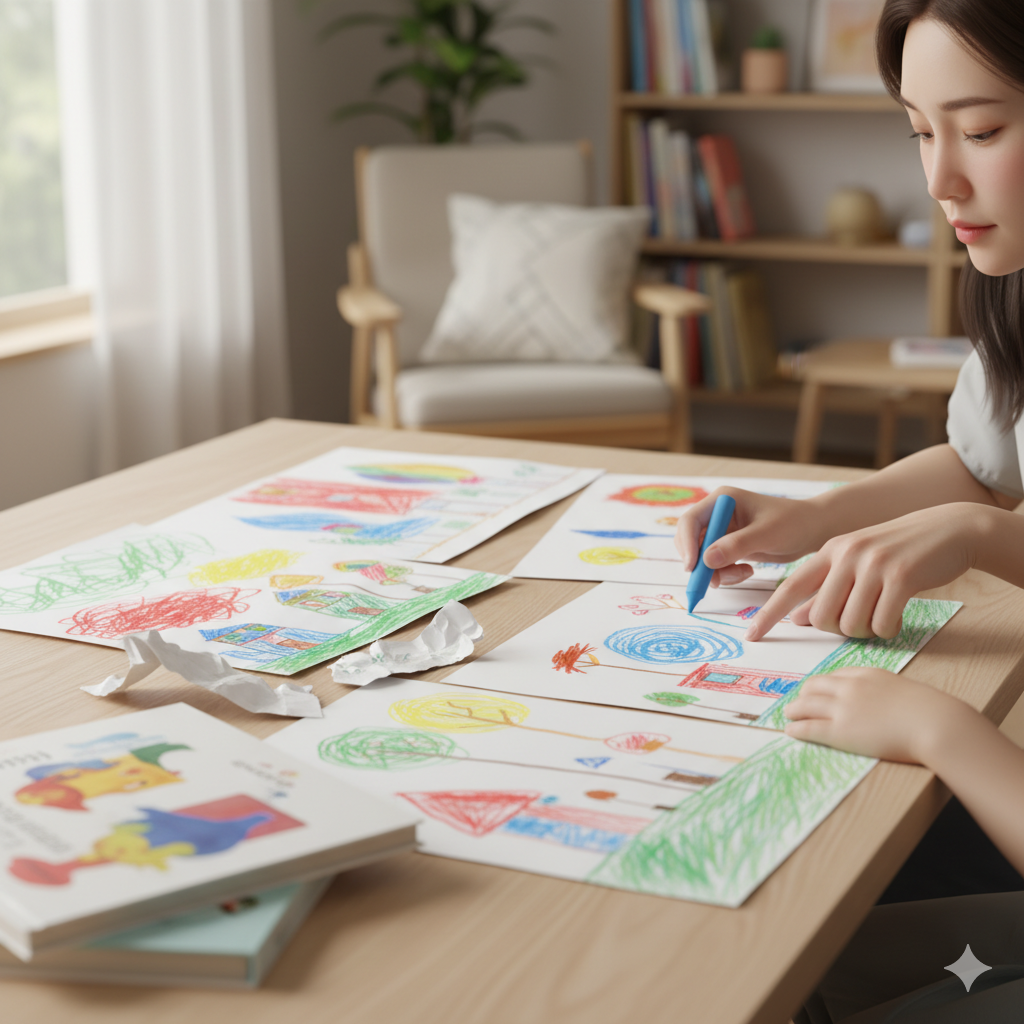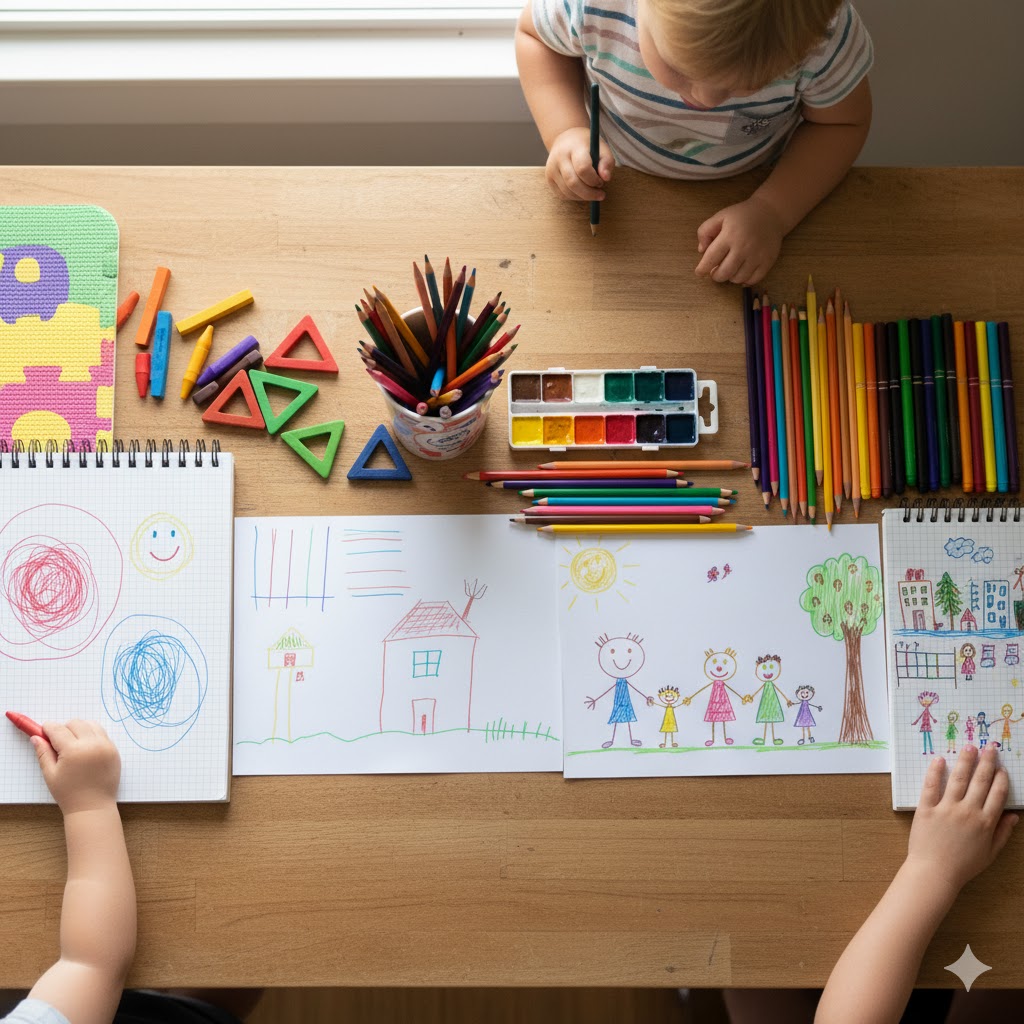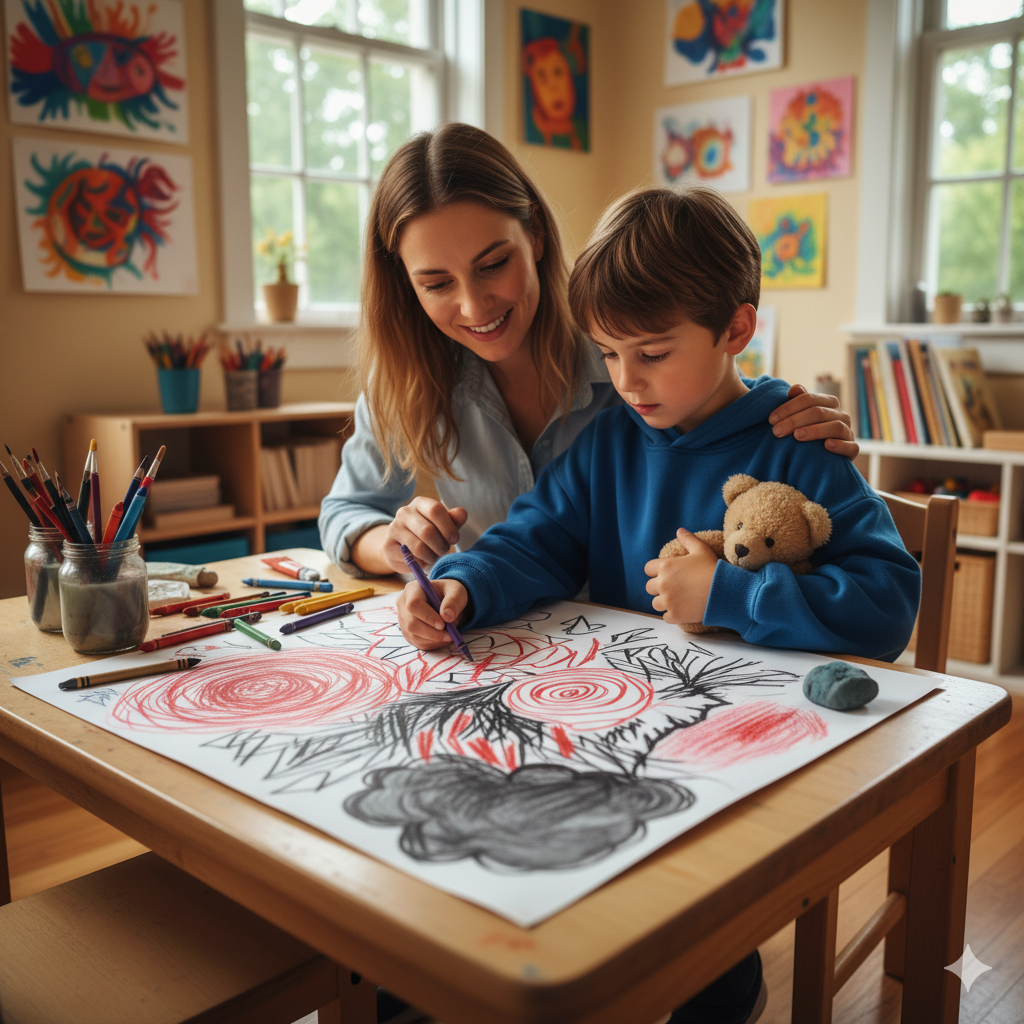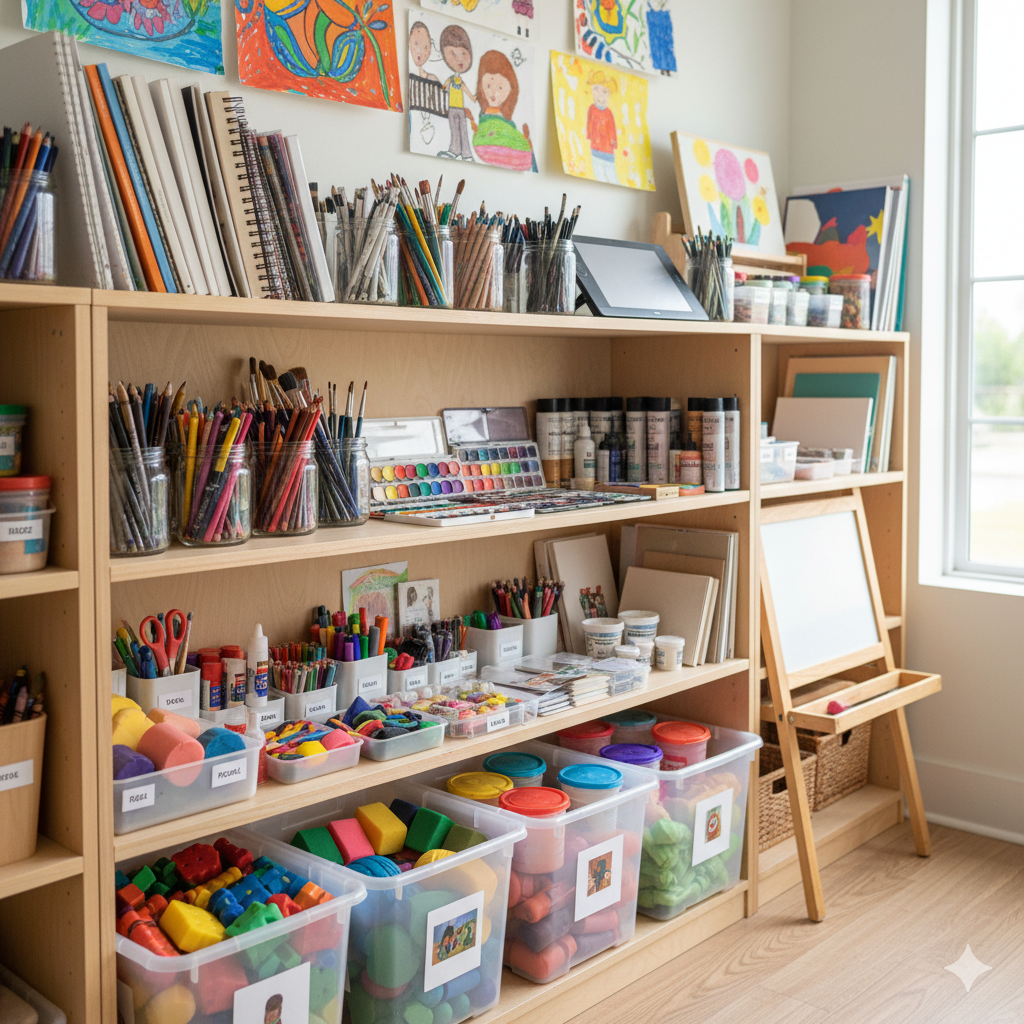Understanding Child Development Through Art: A Parent's Guide
I'll never forget the day my three-year-old handed me a drawing that looked like a jumble of scribbles to my adult eyes, but when she explained it was "Grandma's garden with the big tree and all the flowers," I realized I was looking at something remarkable. That chaotic swirl of lines wasn't just random marks—it was a window into her developing mind, her growing understanding of the world, and her ability to translate her experiences into visual form.
As parents, we often marvel at our children's artwork, hanging their colorful creations on the refrigerator with pride. But these drawings offer so much more than just decorative value—they're actually a fascinating glimpse into your child's developmental journey. Art is more than just creative expression; it's a window into your child's cognitive, emotional, and physical development.
The Amazing Science Behind Children's Art
What's happening when your child picks up a crayon and begins to draw is nothing short of miraculous. Research in developmental psychology has shown that children's artwork follows predictable patterns that reflect their growing abilities, but each child's artistic journey is as unique as their fingerprint.
From the first scribbles of a toddler to the detailed drawings of a school-age child, each stage tells a story about what's happening in your child's developing brain. It's like watching their mind grow in real-time, one drawing at a time.
The Cognitive Symphony
When children draw, they're not just making marks on paper—they're conducting a complex symphony of cognitive processes. Take symbolic thinking, for example. When my daughter draws a circle and calls it a face, she's demonstrating an incredible leap in cognitive development. She's understanding that one thing can represent another, which is the foundation of all human communication and creativity.
Spatial awareness develops through art in ways that constantly amaze me. Watching my son figure out how to draw a house that shows both the front and the sides simultaneously is watching his brain grapple with complex spatial relationships. He's learning to translate three-dimensional reality into two-dimensional representation—a skill that will serve him throughout his life.
Building the Physical Foundation
The physical act of drawing is like a workout for your child's developing motor system. Every time they hold a crayon, they're building the fine motor control that will eventually help them write their name. The hand-eye coordination they develop while drawing is the same coordination they'll use for sports, music, and countless other activities.
I love watching my children's grip evolve over time. My youngest started by holding crayons with her entire fist, then gradually developed the tripod grip that allows for more precise control. Each stage represents important physical development that's happening right before our eyes.
Age-Appropriate Art Milestones
Understanding what to expect at different ages can help you appreciate your child's artistic journey and identify any areas where they might need additional support.
12-18 Months: The Scribble Stage
At this age, children discover the magic of making marks. Their scribbles are typically characterized by large, circular movements using entire arm movements rather than finger control, focusing on exploration of cause and effect with no representational intent.
18 Months - 3 Years: Controlled Scribbling
Children begin to show more control and intentionality with smaller, more controlled movements, beginning to name their scribbles (saying things like "This is Mommy"), creating vertical and horizontal lines, and making first attempts at circular shapes.
3-4 Years: Symbolic Representation
This is when children start creating recognizable symbols, including first human figures (often "tadpole" people), basic shapes representing objects, beginning to use color meaningfully, and stories emerging from their artwork.
4-5 Years: Detailed Realism
Children's drawings become more sophisticated with more detailed human figures including body parts, houses, trees, and other recognizable objects, use of a baseline (ground line), and beginning to show depth and perspective.
5-7 Years: Narrative Art
At this stage, children use art to tell stories through complex scenes with multiple elements, clear narratives in their drawings, beginning to show emotions in figures, and more realistic proportions and details.
What Children's Art Reveals About Development
Emotional Development
Children often express emotions through their artwork that they can't verbalize, including color choices where bright colors may indicate happiness while darker colors might suggest worry, size of figures where large figures might represent confidence and small figures might indicate shyness, placement on page where center placement often indicates importance or self-focus, and facial expressions where even simple drawings can reveal emotional states.
Social Development
Art provides insights into a child's social world through family drawings showing who's included and how they're portrayed, friends and peers revealing social connections and relationships, group scenes demonstrating understanding of social dynamics, and self-portraits indicating self-concept and self-esteem.
Cognitive Development
The complexity of artwork reveals cognitive growth through detail inclusion showing observational skills and memory, proportion understanding indicating spatial reasoning, symbol use demonstrating abstract thinking, and storytelling showing narrative thinking and sequencing.
How to Support Your Child's Artistic Development
Create an Inspiring Environment
Create an inspiring environment with a dedicated art space (even a corner with supplies can inspire creativity), variety of materials where different tools encourage different types of expression, easy access by making art supplies readily available, and display space to show your child that their art is valued.
Encourage Without Directing
Encourage without directing by focusing on process and asking about their experience creating rather than the final product, avoiding corrections and not telling them how to draw "better," asking open questions like "Tell me about your picture" rather than "What is that?," and celebrating effort by praising their creativity and persistence.
Provide Developmentally Appropriate Materials
Provide developmentally appropriate materials including large crayons, finger paints, and thick markers for young children, colored pencils, watercolors, and construction paper for older children, recycled materials for collage and sculpture for all ages, and always ensure safety first by making sure all materials are non-toxic and age-appropriate.
Red Flags: When to Seek Professional Guidance
While most children's artistic development follows natural patterns, certain signs might indicate the need for professional evaluation.
Concerning Patterns
Be aware of concerning patterns including regression where a child who previously drew detailed pictures suddenly only scribbles, repetitive themes of drawing the same disturbing image repeatedly, extreme avoidance of refusing to engage with art materials, and age-inappropriate content with extremely violent or sexual themes for the child's age.
Physical Concerns
Physical concerns to watch for include poor grip with difficulty holding drawing tools appropriately for their age, visual issues where children consistently draw off the page or have difficulty seeing their work, and motor delays with significant difficulty with fine motor control.
Remember: Occasional concerning themes are normal. It's the persistent patterns that warrant attention.
Using Art to Connect With Your Child
Art can be a powerful tool for parent-child connection.
Art as Communication
Use art as communication by listening to their stories since children often share important information through their artwork, asking about their process to understand how they created their art and gain insight into their thinking, respecting their privacy by not forcing them to share if they're not ready, and validating their feelings by acknowledging the emotions expressed in their art.
Making Art Together
Making art together involves collaborative projects to create art together and strengthen your bond, modeling creativity by showing your own artistic process, sharing your own art to let them see you as a creative person, and celebrating differences by appreciating how your styles differ.
The Long-term Benefits of Art
Supporting your child's artistic development has lasting benefits.
Academic Success
Academic benefits include writing readiness as art develops the fine motor skills needed for writing, visual-spatial skills that are important for math and science, creative problem-solving that's valuable across all academic subjects, and confidence where success in art builds overall self-esteem.
Emotional Well-being
Emotional well-being benefits include stress relief as art provides a healthy outlet for emotions, self-expression by allowing children to communicate feelings they can't put into words, achievement through completing art projects that build pride and accomplishment, and identity formation as art helps children explore who they are.
Social Skills
Social skills development includes sharing as art can be a gift for others, collaboration through group art projects that teach teamwork, cultural appreciation as art exposes children to different cultures and perspectives, and communication by providing alternative ways to express ideas.
Conclusion
Your child's artwork is more than just decoration—it's a roadmap of their development. By understanding the developmental significance of their drawings, you can better support their growth and use art as a tool for connection and communication.
Remember that every child develops at their own pace. What matters most is that you provide opportunities for creative expression and celebrate your child's unique artistic voice. Whether they're a budding Picasso or prefer abstract expressionism, their art is a valuable part of their developmental journey.
Want to learn more about interpreting your child's specific drawings? Our AI-powered analysis tool can provide detailed insights into the artistic techniques, developmental milestones, and creative expression in your child's artwork. Try our child drawing analysis tool to get personalized insights about your child's artistic development.
---
This article is for educational purposes only and should not replace professional evaluation. If you have concerns about your child's development, please consult with a pediatrician or child development specialist.



